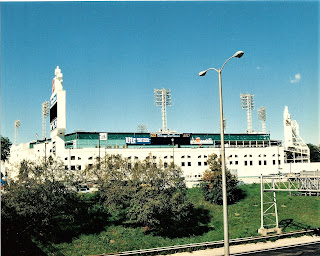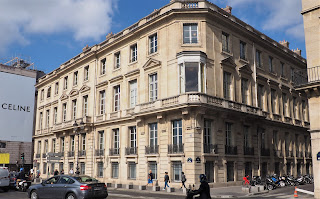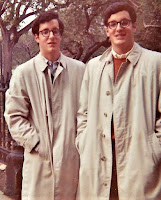On the occasion of what would be her 95th
birthday, it’s time to write about my mother, a woman I’ve described as “lighting
up a room, in more ways than one.”
Model photograph, 1973
Harriet Bloomfeld was born in Chicago on September 8,
1923. She told us her families were from Austria and Russia, without any
details of where exactly they had lived. Until recently, I had the image of the
Bloomfelds as cultured Viennese, while the Saches were probably from Kiev. Abraham
and Sarah Bloomfeld in fact were from Bursztyn, a shtetl in Galicia, then part
of the Austro-Hungarian Empire when they immigrated to the U.S. in the late
1800s. Their town later became part of Poland and now Ukraine. Several members
of Abraham’s family – his sisters had the surname Winz – were murdered in the
Holocaust. I got my name and height from another great-grandfather, Fred Sachs.
At 6’4”, he was almost as tall sitting down as his wife Fannie (about 5’0”) was
standing up.
Fred and Fannie Sachs
Her parents were Meyer and Evelyn, who everybody called
“Cookie” because of her round face. Meyer went straight from Marshall High
School on the West Side to Kent College of Law, interrupting his studies to
serve in the U.S. Navy during World War I. After graduating at age 21, he
flunked the bar exam at least twice and worked as a salesman until the day he
died at age 86.
Meyer Bloomfeld, law school yearbook 1918
Cookie, one of eight children, grew up on Robey Street
(now Damen Avenue) on the site of the present Illinois Medical District. She
graduated from McKinley High School (now Chicago Bulls College Prep) but did
not attend college. Meyer and Cookie married on February 19, 1922. They would
be married for 64 years.
Evelyn "Cookie" Sachs, 1910s
My mother, the first child, was born September 8, 1923,
in Chicago Lying-In Hospital. Somebody in the Sachs had a beef with Michael
Reese Hospital, where most Jewish children were born at the time, so both my
mother and her brother Alan were born at other institutions. Unless I missed
it, mom never told me she originally lived on the North Side. Her birth
certificate lists the family residence as “4036 Magnolia”; however, there is no
4000 block of N. Magnolia Avenue. I later found the true address was 4836 N.
Magnolia, almost around the corner from the Aragon Ballroom. They subsequently
moved to the 5400 block of S. University Avenue in Hyde Park, most likely
before her brother Alan was born in 1930. The building was razed for the
Lutheran theological seminary.
Mom, 1920s
Mom wasn’t big on providing details about her early life.
I don’t know if she attended school in Hyde Park (either Ray or Kozminski
Elementary) before moving to 6902 S. Clyde Avenue in South Shore. The raised
first-floor apartment is across the street from the O’Keeffe Elementary School
playground. She graduated from O’Keefe in 1937. My brother and I would attend
the school 18 years later.
It was on to Hyde Park High School, where she met two
life-long friends, Margie Wallace and Joy Hersh. A girl came up behind my
mother in freshman gym class, togged on her gym suit and asked, “Are you
Jewish?” It was Margie. Mom gift-wrapped the suit and gave it to Margie on the
occasion of her 70th birthday at Chasen’s in Los Angeles. After
Margie died last year, her younger son, Dr. Robert Wallace, returned the gym
suit to me.
Hyde Park High School gym suit, 1930s
Joy Hersh and her husband Henry also moved to Los Angeles
in the early 1960s to avoid Chicago’s winters. She was a very successful
Realtor, once selling a house in Pacific Palisades to one of my second cousins,
then selling it again after she divorced her husband and moved back to New York
City. My parents were visiting the Hershes on their first trip to California, enjoying
the beautiful weather in the backyard of their Brentwood home on August 5, 1962,
when they heard several police and ambulance sirens. The next day they found
that Marilyn Monroe had been found dead three short blocks away. Joy is still
hale and hardy. She provided a few details about mom’s life during our last
phone conversation.
Grandpa Meyer attended South Side Hebrew Congregation, a
Conservative temple, but I doubt mom spent much, if any, time there. She went
to religious school at KAM and then Chicago Sinai Congregation . . . wherever
her friends were going. They would take the bus to the shul on S. Parkway (now
King Drive) and have one person pay the fare, then go to the back and open the
door for the others. Her confirmation-class photograph hangs on the third floor
of the temple, now one-half block from our residence.
Former Chicago Sinai Congregation
Graduating from Hyde Park High School in June 1941, mom made the
long commute from South Shore to DePaul University for one semester. After informing
the instructors she was taking off for Yom Kippur, they said they didn’t
realize she was Jewish. Dropping out after the United States entered World War
II, the war years remained fuzzy to this day. Joy told me they both volunteered
for some type of social-service supporting the war effort, for which my
grandfather drove them downtown. According to Joy, mom also worked as a clerk
in one or more of the Loop department stores.
Mom, early 1940s
On March 22, 1946 (ironically, three years to the day
Frank and I were born), mom was fixed up with a 29-year-old CPA home after
serving as an MP in the U.S. Army in western Illinois. Evidently, things moved
quickly – perhaps in part because both were still living in apartments with
parents and a brother – and they married on September 3, 1946. The independent
type she would always be, mom refused to wear a bridal gown; dad wore a snappy
double-breasted pinstripe suit. They paid the customary post-war bribe to get
an apartment at 7130 S. Cyril Court.
Just married, Sept. 3, 1946
As noted, Frank and I came three years later (nine
minutes apart), an unexpected occurrence until only three weeks before. This
being the tax season, they didn’t have time to buy and set up another crib until
after April 15, so we shared one for a short time. By then they had moved to
6738 S. Merrill Avenue. Babysitters were readily available; Meyer and Cookie
lived three blocks away, and grandma Helen, a widow since 1942, lived one-mile
west. Like other wives of dad’s Phi Epsilon Pi friends, mom tagged along to the
then-infrequent White Sox night games in the early 1950s. During one game, the
man sitting in front of her and Dort Finder (now 98 years old) turned around
and said, “I’m sorry ladies, but I don’t care about the price of chickens at
the High-Low.”
Frank and Fred, Apr. 1949
It was time to move to the suburbs – Frank and I were too
big to share the one bathtub – and a house with a front lawn, attached garage
and backyard. Glencoe would be our home for exactly 15 years, moving in 1955
and back to the city in 1970. Mom stayed home and handled the discipline, since
dad was virtually gone from January 1 to April 15 every year (until going into
private industry in 1963) and traveling to do audits on Pick Hotels, his firm’s
major client. In 1961, Frank and I did something egregious enough for her to
ban us from watching the first game of the World Series. She went downtown to
meet friends that day, leaving us to come home for lunch and turn on the game.
Upon arriving home after school, she greeted us with “You watched the World
Series, didn’t you?” The big black-and-white box had long since cooled, but I knew
she wasn't bluffing. “Yes,” I replied, “how did you know?” “Because the channel
selector was on Channel 12 when I left and on Channel 5 when I came home,” she
answered. An early lesson in thinking several steps ahead, indeed.

Mom and Dad, early 1960s
I am forever grateful for her insisting on our learning
manners and helping around the house. Cooking was encouraged; cleaning was
required. We were taught to say, “Yes, sir” and “Yes, ma’am,” to look people in
the eye when taking and to write intelligent thank-you notes. One of the
greatest compliments I’ve received was from the mother of my college freshman’s
roommate, who said “Sign of a good upbringing” after performing some routine
task. On the other hand, mom was the arbiter of profanity; dad never swore so
it only became permissible if mom said it. She was actually pretty liberal
about it.
Mom spent much of her time over the years doing volunteer
social service. She was the co-chairman (as they were called back then) of the
annual Brandeis University Book Fair in the early 1960s when it was held in a
temporary storefront in downtown Winnetka. The Council for Jewish Elderly and
JCC were favorite organization for which she contributed time.
Fred, Mom and Frank, mid-1960s
At the risk of TMI, mom had major surgery in summer 1964
that illustrates how much things change. Frank and I were at summer camp, and
the director, Nardie Stein, informed us my mother was in the hospital for
surgery, and he had arranged with my father to call her. The telephone system
in northern Wisconsin was still primitive in those days, so Nardie had to call
an operator to place the call. He then handed the phone to me, after which I
was told nobody named Harriet Nachman was registered there. Panic-stricken, I
said, “Is this Passavant Hospital?” “No, this is the Water Tower Inn” was the
reply. What a relief!
BTW, it was a
hysterectomy, and dad had to explain what it is to his 15-year-old sons.
We were among the first suburban families to move back
into the city, returning while Frank and I were still in college. They
purchased a condominium on N. Lake Shore Drive, which cut dad’s commute time to
the office. One of their friends needed an attractive, prematurely gray-haired
woman to do a three-part commercial for Toni Magic Moment for the 1970 Miss
America Pageant. Mom was chosen; it concluded with “I’m a brunette again!”
Advertisement, early 1970s
On March 29, 1973, barely two months after Janet and I
married, mom returned home in the late afternoon to find her brother waiting in
the lobby. She figured if something had to do with their parents, 76 and 73, he
would have called from his Hancock Building office. Alan told her my father had
died suddenly at age 55. As noted here, it hit us like a ton of bricks.
http://brulelaker.blogspot.com/2010/12/sudden-death-in-family.html
Mom was just short of 50 at the time.
Not too long after, mom told me she would like to marry
again. Once the shock wore off – who could possibly replace my father? – I
realized she couldn’t spend the rest of her life mourning the tragic loss. One
year later, after a few “dates” that went nowhere, she met Irving Nathan, who
had been divorced for a few years. Irv was the opposite of my father –
outgoing, a born salesman and good-time charley – which was a good thing, for
he took what were eventually the seven of us (Frank, Martha, Grant, Julia,
Janet, Marisa and me) as his own. They traveled the world together, too many
places to list, on what mom called “a long date.” Winters were eventually spent
first in Phoenix, San Diego and Palm Springs. Old friends remained as they made
new friends.
Irv and Mom, mid-1970s
I came to realize mom considered Janet to be more her
wonderful daughter and me the pesky son-in-law. Coming from Brooklyn knowing
nobody in Chicago, Janet needed large doses of support, especially after the
tragedy that virtually kicked off our marriage. Mom did countless things for
her and never stopped extolling her virtues to friends and family.
Janet and Mom, 1973
Irv’s health took a turn for the worse in 1996, and he
passed away that August. After two marriages, mom figured it was enough and
very much enjoyed the single life. Thanks to my uncle Adolph and aunt Ros and,
later, her good friend Sonya Reich, mom traveled to Europe twice, as well as
taking the entire family on a Mediterranean cruise. She accompanied us to New
York City several times, always a fun getaway, and kept busy volunteering for
Working in the Schools (WITS) and Jewish Community Centers (JCC).
Mom, Janet, Lady Liberty and me, New York City, July 2008
Mom was planning for her 90th birthday
celebration in September 2013 when her health began deteriorating. We shared an
internist, who told me mom practiced “ostrich medicine.” She often said if
anything was found, she was too old to treat it. Constant spinal pain got
progressively worse, and she suffered a stroke in March. After a few days, the
doctors sat us down and, to our surprise, told us scans showed pervasive cancer
throughout her upper body and would be discharged into hospice care. The end
came rather swiftly – two weeks – and the entire family were with her until
right before she passed away. Her death on March 26 was three days before the
40th anniversary of my father’s death.
Not a particularly religious person – she had resigned
her temple membership a few years earlier after 30+ years – mom often said she
didn’t wasn’t a rabbi at her funeral. Because it wasn’t in writing, I
considered having somebody officiate. Before that, I had found my father’s
prayer book from his South Shore Temple confirmation in 1932 that contained a
mourner’s service. I took parts of it – retaining its beautiful archaic
language – and led the service, calling on those in attendance on the cold but
sunny afternoon, to speak as they may. Sonia led off with a very poignant
tribute as did several others.
My father's prayer book, 1932
Mom was not the most patient person, so I opened my
remarks with, “I don’t know about you, but I think I heard mom say, ‘C’mon
already!’” I said I’d apologized to Joy for mom being short with her in recent
months; she’d replied with a laugh, “She was always short with me!” I concluded
with one of hers and one of my favorite sayings: “It’s been charming” and “When
you see dad, tell him everything turned out all right.” Even after five years,
Janet and I still have many “Wait ‘til mom hears this one” moments. This is
another one.

































































